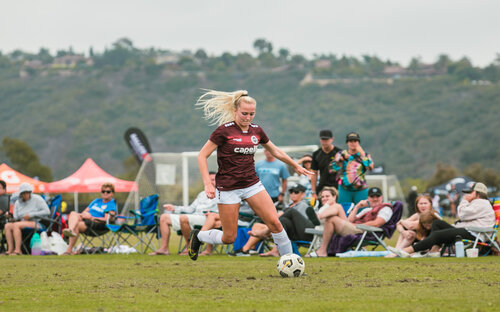

Last week we shed some light on the twisting tale of US men’s professional soccer. That history — full of confusion and conflict and general disagreement — goes back 100 years.
This week, we’re diving into the much shorter, slightly less convoluted history of women’s professional soccer in the United States. Where the chaos in the men’s game stems from greed, that’s not the case here. Until recently, there hasn’t been enough money in the market — most attempts to create a thriving professional women’s league ended up stifled by financial constraints and a perceived lack of public interest.
Thankfully, that’s no longer the case. Inspired by the national team’s incredible success, women’s soccer is on a meteoric rise. In 2020, NWSL viewership average 400,000 per game, comparable to NHL viewership. And high-profile corporate sponsorships rolled in. Female soccer participation is at an all-time high, from youth soccer to the collegiate level. And the U.S Women’s national team continues to dominate and will enter the 2023 World Cup as reigning champions.
⭐️ 𝐓𝐇𝐄 𝐑𝐀𝐓𝐈𝐍𝐆𝐒 𝐀𝐑𝐄 𝐈𝐍⭐️
— National Women’s Soccer League (@NWSL) November 23, 2021
The @WashSpirit‘s ET victory on @CBS averaged 525K Viewers, Up +216% from the 2019 NWSL Championship 📈
571K Viewers tuned in for the final half hour ✨
The match was the most-streamed NWSL game on @paramountplus this season 🗻 pic.twitter.com/XytpCFvOcG
Despite these successes, there are only 10 top-level professional teams, and opportunities for young women to continue playing past college are few and far between.
But that’s changing. New, exciting developments promise to streamline young women’s paths into professional soccer’s bright future.
A Brief History of Women’s Professional Soccer

The first US women’s semi-professional soccer league wasn’t formed until 1995. (For reference, that’s four years after our national team won the first FIFA Women’s World Cup.) The USL W-League was quickly joined by the Women’s Premier Soccer League, which debuted in 1998.
In 2000, after the national team’s dramatic and high-profile 1999 World Cup glory, women’s soccer emerged as a “viable market.” In 2000, the eight-team Women’s United Soccer Association launched as the first truly professional women’s soccer league, boasting a broadcast deal, stadiums for some teams, and a farm club agreement with the expanding W-League. This marked the first attempt toward building a self-sustaining development system to help players reach the top level.
But the WUSA’s promising start quickly tapered off, and the league dissolved after three seasons with cumulative losses of $100 million. Plans to relaunch the league got delayed year after year. Finally, a seven-team Women’s Professional Soccer league debuted in 2009, operating on a smaller scale with a partnership with MLS. But in 2012, again after only three seasons, the WPS officially folded.
At this point, the United States Soccer Federation took a more hands-on approach. A 2012 joint venture between the American, Canadian and Mexican soccer federations launched the National Women’s Soccer League. It took until 2015 for the NWSL to sign their first broadcast deal, boosted by a resounding World Cup victory.
In 2016, the NWSL became the longest-running professional women’s soccer league in the country. It was only their fourth season. Today, the NWSL includes ten teams, with two more expected to join in 2022. The MLS, by contrast, boasts 28.
Thriving Lower Divisions of Women’s Soccer

Below the top tier, things have gone more smoothly. The WPSL continues to thrive as a second-tier development organization and the world’s largest women’s soccer league, with 141 active teams. The WPSL also launched a U21 summer league this year.
Operating on the same pro-am level as the WPSL, United Women’s Soccer was founded in 2015 to replace the now-defunct W-League. In 2020, they announced the formation of UWS League Two, a U23-focused competition featuring a unique (to the US) promotion/relegation relationship with UWS League One. There are currently an impressive 94 teams competing across those two divisions.
Despite these successes, however, neither the WPSL nor the UWS is technically a professional second-division competition. That title will belong to the newly-announced USL Super League, which is set to launch in 2023 as the country’s first sanctioned division two women’s league, sitting right below the NWSL.
USL Paves the Pathway to Pro
The USL Super League aims to fill a crucial void in the women’s soccer pipeline, starting with doubling the number of professional women’s teams by its inaugural season and ending with providing unprecedented opportunities and pathways for youth players to attain their professional dreams.
But that’s not all. In February 2021, the USL also announced plans for a new women’s pre-professional league, the USL W League. Their vision is “to use women’s soccer as a force for societal good by creating a national platform to increase opportunity, gender equity, and career development.” The USL W League will kick off its inaugural season in May 2022 with at least 30 teams of elite amateur players.
Together with USL’s Academy program and the well-established (youth) Super League, USL is well on its way to becoming the first-ever US soccer organization to promote a full youth-to-pro pathway for young women. That means more opportunities than ever to learn in professional environments.

